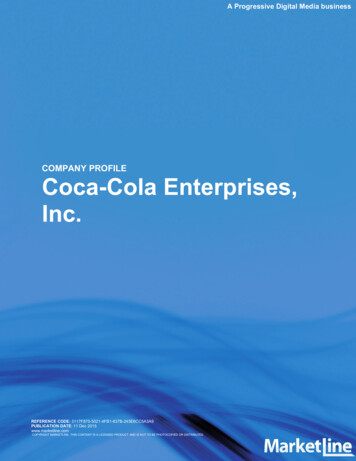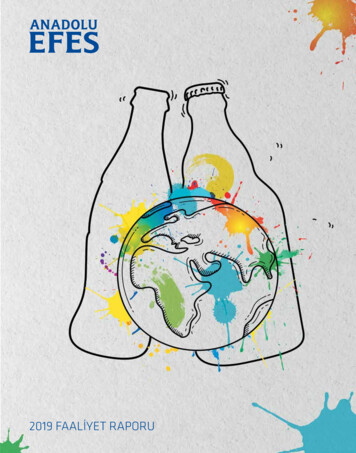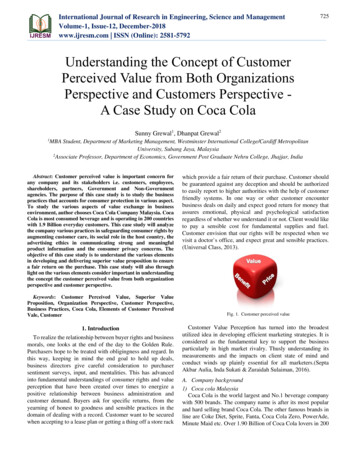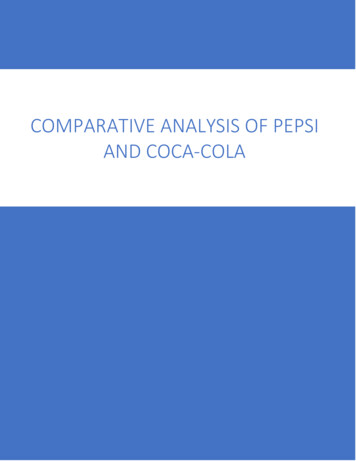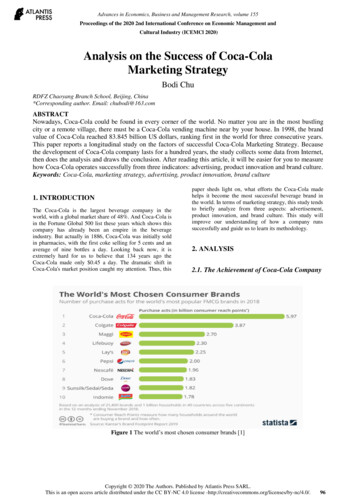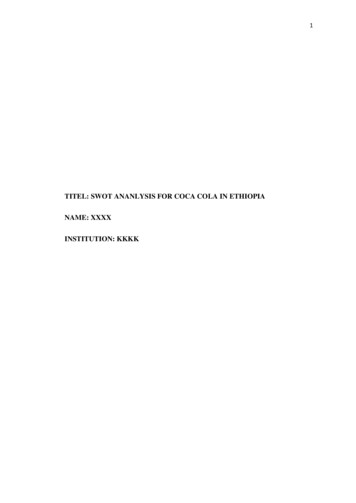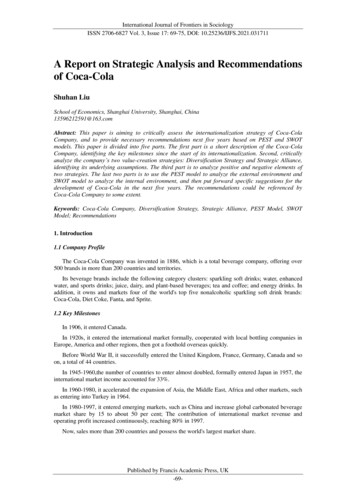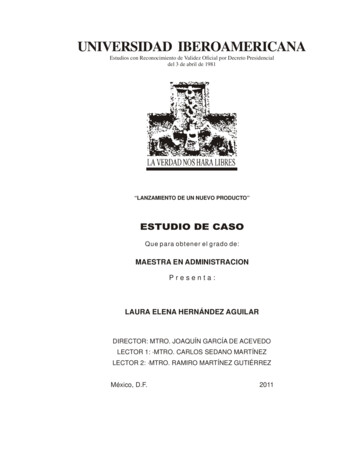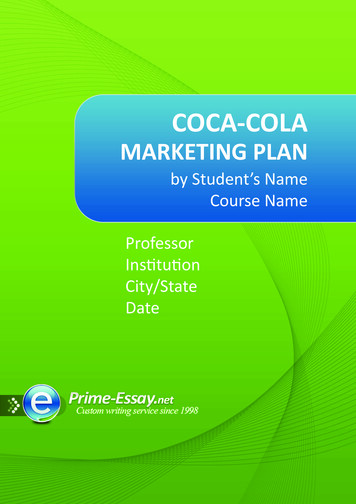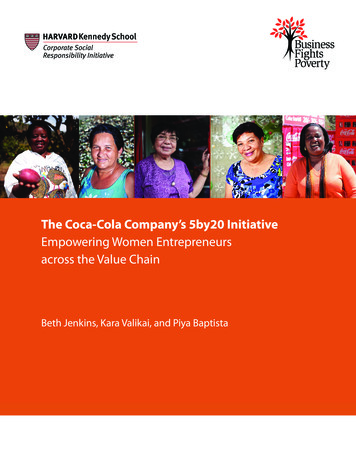
Transcription
The Coca-Cola Company’s 5by20 InitiativeEmpowering Women Entrepreneursacross the Value ChainBeth Jenkins, Kara Valikai, and Piya Baptista
Written by Beth Jenkins, Kara Valikai, and Piya BaptistaDesigned by Alison BeanlandCover photographs (from left to right): Mama Njeri, Mango Grower, Kenya; Zilda Bareto, Recycling Cooperative Founder, Brazil; BernaditaRibamonte, Sari-Sari Store Owner, Philippines; Regina Maria Silva Gomes, Recycling Cooperative Founder, Brazil; Rosemary Njeri, Micro DistributionCenter Owner, Kenya. Photo credits: The Coca-Cola Company.ACKNOWLEDGEMENTSThis report would not have been possible without the collaboration of a large number of stakeholders. The authors are deeply grateful for theiropenness and generosity with their time. Special thanks go to The Coca-Cola Company’s senior executives Xiemar Zarazúa, President, BrazilBusiness Unit; Guillermo Aponte, President and General Manager, Coca-Cola Philippines; and Charlotte Oades, Global Director, Women’s EconomicEmpowerment for sharing their insights and experiences. Additional thanks go to Marika McCauley Sine, Angie Rozas, and Sandy Chapman formaking introductions, facilitating engagement with the broader group of stakeholders, and making productive research visits possible, in additionto sharing their own insights and experiences.The broader group of stakeholders consulted for this report include:Ian Alaras, Owner, Red Runner(Market Logistics Partner forCoca-Cola FEMSA Philippines)Guillermo Aponte, President andGeneral Manager, Coca-Cola PhilippinesRonald Asuncion, Director of BusinessDevelopment, Coca-Cola FEMSAPhilippinesJulius Ayebare, Capability Development/Route to Market Manager, Coca-ColaKwanza, TanzaniaErnesto Beltran, Former Chairman, STARProgram National Project ManagementTeam, TESDASandy Chapman, Project Manager,International Government Relations andPublic Affairs, The Coca-Cola CompanyJackie Duff, Strategic Project Director,Women’s Economic Empowerment,The Coca-Cola CompanyElla Gonzales, Strategy Managerfor General Trade, Coca-Cola FEMSAPhilippinesMarta Hernandez, Executive Director,Technical Vocational SystemsDevelopment Office, TESDA, and actingCo-Chairperson, STAR Program, NationalProject Management TeamKristin Hetle, Director, StrategicPartnership Division, UN WomenMaria Clara B. Ignacio, Center Chief,TESDA Women’s CenterChuck Jereos, Regional Director, SouthLuzon, Coca-Cola FEMSA PhilippinesApril Jordin, Director, Corporate ExternalAffairs, The Coca-Cola CompanyAlfeu Junior, Regional Manager, RawMaterials, The Coca-Cola CompanyFrancisco Meirelles, OperationsCoordination, Coletivo Coca-Cola,Instituto Coca-Cola BrasilAdrian Ristow, Special Projects Director,International Government Relations andPublic Affairs, The Coca-Cola CompanyRenilda Molina, Sari-Sari Store Owner,Bacolod, PhilippinesAngie Rozas, Strategic Project Director,Women’s Economic Empowerment,The Coca-Cola CompanyErastus Mtui, Country Public Affairsand Communications Manager,Coca-Cola Kwanza, TanzaniaJoy Munsayac, Program Consultant,Kenneth Kamulegeya, Country Sales andCoca-Cola PhilippinesMarketing Manager, Coca-Cola Kwanza,TanzaniaLeonardo Musmanno, PlanningManager, The Coca-Cola CompanyMar Lazaro, President,1Pinoy Financial ServicesFlavia Neves, Sustainability Manager,The Coca-Cola CompanyClaudia Lorenzo, Social Business Director,The Coca-Cola Company BrasilMa. Theresa R. Nunez, Training Manager,Negros Women for Tomorrow Foundation,Jerry Mamucud, Field Sales Manager,Bacolod City, PhilippinesCoca-Cola FEMSA PhilippinesCharlotte Oades, Global Director,Gilda Patricia Maquilan, SustainabilityWomen’s Economic Empowerment,and Government Affairs Manager,The Coca-Cola CompanyCoca-Cola Philippines andCo-Chairperson, STAR Program,Perry Pascol, General Sales Manager,National Project Management TeamManila G7 Area, Coca-Cola FEMSAPhilippinesManuel L. Margate, Training Manager,Negros Women for Tomorrow Foundation, Merlin Prajes, Sari-Sari Store Owner,Bacolod City, PhilippinesBacolod, PhilippinesPedro Massa, Social Business,Instituto Coca-Cola BrasilJulio Cesar Santos, Secretary General,Doe Seu LixoMarika McCauley Sine, Group Director,International Government Relations andPublic Affairs, The Coca-Cola CompanyTerrez Thompson, Vice President,Global Supplier Diversity,The Coca-Cola CompanyAdel Tamano, Public Affairs andCommunications Director,Coca-Cola PhilippinesThais Vojvodic, Operations Manager,Coletivo Recycling, Instituto Coca-ColaBrasilLorena Yunque, Provincial Director,Negros Occidental, TESDAXiemar Zarazúa, President, Brazil BusinessUnit, The Coca-Cola CompanyDaniela Redondo, Social ProgramsManager, Instituto Coca-Cola BrasilSusan Mboya, Group Director,Eurasia and Africa, Women’sEconomic Empowerment,The Coca-Cola CompanyThe authors would also like to thank their CSR Initiative colleagues Jane Nelson, who provided invaluable experience, insight, and guidancethroughout the research and writing process, and Marli Porth, who provided objective feedback and copy-editing in the report’s final stages.Zahid Torres-Rahman and Richard Gilbert from Business Fights Poverty also contributed critical insight and feedback. 2013 by the CSR Initiative at the Harvard Kennedy School and Business Fights PovertyThe material in this publication is copyrighted. Quoting, copying, and/or reproducing portions or all of this work is permitted providedthe following citation is used:Jenkins, Beth, Kara Valikai, and Piya Baptista (2013). “The Coca-Cola Company’s 5by20 Initiative: Empowering Women Entrepreneurs acrossthe Value Chain.” Cambridge, MA: The CSR Initiative at the Harvard Kennedy School and Business Fights Poverty.The views expressed in this paper are those of the authors and do not imply endorsement by the John F. Kennedy School of Government,Harvard University, Business Fights Poverty or The Coca-Cola Company.
The Coca-Cola Company’s 5by20 InitiativeEmpowering Women Entrepreneurs across the Value ChainBeth Jenkins, Kara Valikai, and Piya Baptista
ForewordTackling poverty, unemployment, and genderinequality, improving food, water and energysecurity, increasing access to education, healthcare and nutrition, and adapting to climate changeare pressing development challenges. They are alsoincreasingly important dimensions of the strategicand operational context for business around theworld, creating new business risks, as well ascommercially viable business opportunities forcompanies in a variety of industry sectors.The development community has come to recognizethe private sector as a crucial partner in helping toaddress these challenges. New technologies, productsand services, and more inclusive business modelsare helping to improve livelihoods and quality oflife for millions of low-income households whileat the same time improving the efficiency ofnatural resource use and decreasing environmentaldegradation. At the same time, companies are usingsocial investment, philanthropy, and public policydialogue to expand and enhance the impact of corebusiness activities.Of the many development challenges facing ourincreasingly interconnected and interdependentworld today, reducing poverty – or, put anotherway, expanding economic opportunity and choice– is among the most pressing.Expanding economic opportunity and choice isalso a challenge that companies have a comparativeadvantage in addressing through their core businessoperations and value chains. I first introduced thisidea in a 2003 policy paper entitled “EconomicMultipliers: Revisiting the Core Responsibility andContribution of Business to Development.”1 Anincreasing number of economic multiplier studieshave demonstrated the impact. For example, a 2010study of the bank Standard Chartered in Ghanarevealed that it generated 400 million in economicvalue-added, approximately 2.6% of GDP, andsupported nearly 156,000 jobs, approximately 1.5%of the workforce.2 A similar study of multinationalbrewer SABMiller in Honduras in 2009 revealedthat its local subsidiary, Cervecería Hondureña,generated 405 million in economic value-addedand supported 100,000 jobs.3 And yet the role of theprivate sector in expanding economic opportunityand choice has been a relatively neglected part of thecorporate social responsibility debate. It is one thatthe CSR Initiative at the Harvard Kennedy Schoolhas endeavored, over the years, to address.Since it was founded in 2003, the CSR Initiative hasworked to bridge theory and practice in the field ofbusiness and development. This report is part of aseries focused on the role companies play – often inpartnership with governments, non-governmentalorganizations, donors, and other companies – inexpanding economic opportunity and choice. Thereport focuses on The Coca-Cola Company’s 5by20initiative, which aims to improve the economicempowerment of five million women entrepreneurswithin the Company’s global value chain by 2020.By studying and sharing some of the early lessonsof implementing this initiative in “real time,” wehope that it will be possible for other companiesand development partners to accelerate theirown progress in developing models that achieveboth business benefit and development impactthrough tackling some of the world’s most pressingdevelopment challenges.Jane NelsonDirector, CSR InitiativeMossavar-Rahmani Center for Business andGovernmentHarvard Kennedy School4 The Coca-Cola Company’s 5by20 Initiative EMPOWERING WOMEN ENTREPRENEURS ACROSS THE VALUE CHAIN
The Coca-Cola Company’s 5by20 InitiativeEmpowering Women Entrepreneurs across the Value Chain1. Introduction62. The 5by20 Commitment73. 5by20 in Action83.1 Producers163.2 Distributors203.3 Retailers243.4 Recyclers283.5 Artisans324. Cross-Cutting Keys to Sustainability and Scale354.1 The Business Case for Coca-Cola354.2 The Business Case for Women Entrepreneurs364.3 Scalable Assets and Approaches374.4 Institutional Capacity and Incentives to Deliver395. Conclusions and Recommendations42Endnotes44The Coca-Cola Company’s 5by20 Initiative EMPOWERING WOMEN ENTREPRENEURS ACROSS THE VALUE CHAIN 5
1. IntroductionIn the context of prolonged economic crisis, fuelingand sustaining growth is at the top of the globalagenda. Policymakers are urgently searching forthe right mix of rules and incentives. At the sametime, when it comes to action, the private sectormust play a central role.Private sector firms fuel economic growth bypurchasing raw materials, investing in equipmentand infrastructure, driving job creation, raisingskill levels, transferring technology, generating taxrevenues for governments, and providing goodsand services that people need to be productive. Inaddition, firms have the potential to help sustaineconomic growth by making it more inclusive –expanding economic opportunity for populationsthat have traditionally faced barriers to participatingin, and benefiting from, formal markets. Anemerging body of research by the InternationalMonetary Fund and others suggests that inclusivegrowth is more sustainable and leads to greater gainsover time.4As companies procure, produce, distribute, andsell goods and services, they expand economicopportunity for the individuals and enterpriseswith which they do business all along their valuechains. And as they search for high-growth marketsand new and more reliable sources of supply, manycompanies are finding ways of doing business withpreviously underappreciated segments like the poor,women, and youth. For example, food, beverage,and consumer products companies are distributingthrough small businesses and micro-entrepreneurs inorder to reach underserved low-income consumers.Traders and processors of agricultural commoditiesare buying from smallholder farmers to expand anddiversify their supplies. Microfinance institutions –and some large commercial banks – are extendingsmall loans to low-income borrowers, many of themwomen, using alternative forms of due diligence andrisk management. And they are doing it profitably,and in some cases at scale.But companies doing business in these marketsalso have to overcome significant challenges alongthe way. Too often, the poor, women, youth, andsimilar segments remain underserved because ofbarriers like insufficient information about theircapabilities, needs, and aspirations; low levels ofeducation and skills; limited access to financialservices; social and cultural norms; misguided publicpolicies; and inadequate physical infrastructure.5Many companies have used social investment andpartnership with governments, non-governmentalorganizations (NGOs), and donors to help addressthese barriers.This report focuses on one ambitious example,The Coca-Cola Company’s 5by20 initiative. 5by20aims to expand economic opportunity for five millionwomen entrepreneurs throughout the Company’sglobal value chain by the year 2020 through acombination of core business operations, crosssector partnership, and strategic social investment.Launched in 2010, the initiative has alreadyreached 300,000 women producers, suppliers,distributors, retailers, recyclers, and artisans in12 countries. Initiatives at every step of the valuechain, while most of them are relatively new, havestarted to generate useful lessons and insights. Bydocumenting these, we hope to inform and inspireThe Coca-Cola Company, its bottling partners,and other companies, governments, NGOs, anddonors that are working to scale up business’ impacton economic growth and opportunity around theworld.6 The Coca-Cola Company’s 5by20 Initiative EMPOWERING WOMEN ENTREPRENEURS ACROSS THE VALUE CHAIN
2. The 5by20 CommitmentThe Coca-Cola Company sells more than500 still and sparkling beverage brandsin more than 200 countries at a rate ofmore than 1.8 billion servings per day. In theprocess, the Company creates jobs and businessopportunities for agricultural producers, suppliersof goods and services, manufacturers and bottlers,distributors, retailers, packaging recyclers andartisans. The Company, in turn, depends on theseindividuals and enterprises to operate and grow.In developing countries and emerging markets,many of these enterprises are owned or managedby women. On the retail side, women have a strongpresence in the so-called “traditional trade,” runningmany of the corner stores, kiosks, market stalls, andstreet carts that make up one of the Company’smost important sales channels. On the supply side,the Company is working to expand and diversifyits sources of agricultural commodities like coffee,tea, citrus, and other fruits around the world. Indeveloping countries, half of potential sources – halfof all farmers – are women.6 Women are also theprimary buyers of Coca-Cola products.its growth targets are ambitious: its 2020 Vision andRoadmap calls for doubling the size of the business,by servings and by revenue, by the year 2020. Atthe same time, the Company recognizes that womenface special hurdles to business entry and growth.2008 research by the CSR Initiative at the HarvardKennedy School and IFC (International FinanceCorporation) showed that the primary hurdlesfor women Micro Distribution Center owners inEast Africa were low levels of business skills, lackof access to finance, and limited networks of peersand mentors.7 Further stakeholder engagementand dialogue confirmed that these hurdles existedfor women entrepreneurs at many points along thevalue chain.With the business imperative in mind,The Coca-Cola Company made a commitmentto address these hurdles to help economicallyempower five million women entrepreneurswithin its global value chain by the year 2020at the 2010 Clinton Global Initiative in NewYork. Dubbed “5by20,” the commitment is intendedto drive progress not only toward the Company’s2020 Vision growth goal, but also toward broaderThis means that The Coca-Cola Company cannot national and international economic and socialrealize its potential for growth without women. And development goals (see Box 1).Box 1. Women’s Economic Empowerment as a Development DriverAround the world, women experience lower levels of assetownership, formal sector employment, decision-making power,and economic opportunity and earnings than men. These gapsconstrain economic growth and development. For example,the International Labor Organization estimates that the gap inemployment rates between women and men costs the AsiaPacific region alone approximately 47 billion per year.8On the other hand, there is increasing consensus that women’seconomic empowerment is a powerful economic growth anddevelopment driver. For instance, Goldman Sachs estimates thatclosing the gender gap in 15 high growth potential emergingmarkets could increase projected per capita incomes there by14% by 2020 and 20% by 2030.9 In a McKinsey & Company surveyof senior private sector executives, 34% of respondents reportedthat their women’s economic empowerment efforts increasedprofits, and an additional 38% projected that their efforts wouldincrease profits in the future.10At the same time, studies show that women’s economicempowerment has positive multiplier effects on nutrition, health,and education. For example, the Food and Agriculture Organizationreports that closing the gap in female smallholder farmers’ accessto improved agricultural methodologies and resources couldreduce the number of under-nourished people by 12-17%.11 Andcountry studies from Mexico to South Africa to the United Kingdomshow that women are more likely to spend their incomes on goodsand services that benefit their children, like food and healthcare. 12The Coca-Cola Company’s 5by20 Initiative EMPOWERING WOMEN ENTREPRENEURS ACROSS THE VALUE CHAIN 7
3. 5by20 in ActionThe Coca-Cola Company began working toward its 5by20 commitment in Brazil, India, thePhilippines, and South Africa in 2010. Since then, 300,000 women have participated in 5by20initiatives in 12 countries.13 The Company expects 5by20 initiatives to reach 1.5 million women in20 to 30 countries by 2015 and 5 million women in 100 countries by 2020.The Coca-Cola Company is implementing 5by20through a portfolio of initiatives that combinecore business operations, cross-sector partnership,and strategic social investment to bring down thebarriers women face to participating and growingtheir businesses at every stage of the value chain.To reach five million women by 2020, sustainable,scalable models are required. In a business systemas decentralized as Coca-Cola’s, where operationsare driven by 20 regional business units and nearly250 bottling partners around the world, localembeddedness is a key ingredient in sustainabilityand scale. To succeed, programs must be drivenregionally and locally, in line with local businesspriorities, capabilities, and resources – andfundamentally the context and needs of the womenthey are intended to empower.A small global team has been established to develop anintegrated, global women’s economic empowermentstrategy and to provide strategic leadership andsupport for regional and local teams and their partnersas they develop 5by20 programs. Reporting toThe Coca-Cola Company’s Chief SustainabilityOfficer, this global team is comprised of peoplewith diverse business backgrounds, from strategyto marketing to public affairs, with many yearsof experience within the Coca-Cola system. Thisprovides an understanding of the parameters withinwhich their local counterparts operate as well as theskillsets required to advise and support them. Theglobal 5by20 team has identified six best practicesthat guide its work:1. Start with the local business plan. The global5by20 team starts by speaking with senior businessunit leaders about how they are planning to growtheir businesses – and then asking how thosegrowth plans depend on or impact women. Theyidentify places where women play important rolesin the value chain, explore the cultural context forthose roles, and the needs those women face. Thenthe global and local teams work together withkey stakeholders and partners to identify existingprograms that could be tailored to women and/orexplore the scope to create new programs.2. Get the right people around the table. The global5by20 team has found that it is important to startthe dialogue with senior business unit leaders toobtain their buy-in and to facilitate connectionsthroughout the local business. Many 5by20country programs involve both operations (todevelop programs that align with businesspriorities and design effective processes) andpublic affairs and communications (to facilitateexternal dialogue and partnership). Many countryprograms also involve external stakeholders suchas community leaders, government agencies, andNGOs. Anyone with a role to play in decisionmaking and implementation needs to be at thetable as 5by20 programs are conceptualized,designed, and rolled out.8 The Coca-Cola Company’s 5by20 Initiative EMPOWERING WOMEN ENTREPRENEURS ACROSS THE VALUE CHAIN
Box 2. Background on the Coca-Cola Value Chain and the Coca-Cola SystemThe Coca-Cola CompanyProducersAgricultural producers,large and small, thatgrow sugar, coffee,orange, mango, andother cropsSuppliersBottlersCompanies thatsupply nt,services, etc.Nearly 250manufacturersthat produceand bottleCoca-Colabeverages in200 countriesSee insetDistributorsBusinesses thatdeliver beveragesfrom bottlers toretailers usingmethods rangingfrom large trucksto pushcartsRetailersRestaurants, hotels,supermarkets,mom-and-popshops, kiosks, andstreet vendors thatsell products toconsumersCoca-Cola’s more than 500 beverage brands are manufactured,marketed, and consumed in more than 200 countries at a rateof more than 1.8 billion servings per day through a complexand decentralized global value chain that spans producers ofraw materials; suppliers of ingredients, packaging, equipment,and other goods and services; bottlers who manufacture,package, and distribute (or contract third parties to distribute)beverages; retailers who purchase those beverages for resale toend consumers; and recyclers and artisans who reuse productpackaging.The Coca-Cola Company, headquartered in Atlanta in the UnitedStates, owns the beverage brands and the “secret formula” for itstrademark product, Coca-Cola. The Company’s role in the valuechain is to conduct consumer brand marketing, building demandfor Coca-Cola products, and to manufacture and sell concentrates,syrups, and beverage bases to bottlers. The Coca-Cola Companyhas nearly 250 bottling partners, only approximately 50 of whichare partially or wholly owned by the Company.RecyclersIndividuals andcooperatives thatcollect, sort, andsell discardedbeverage packagingto brokers andplants for recyclingArtisansIndividuals andcooperatives who usediscarded beveragepackaging to createjewelry, handbags,home décor, andother items for saleThe Coca-Cola SystemThe Coca-Cola CompanyManufactures and sells concentrates,syrups, and beverage bases to bottlers;provides formulas and recipes; ownsbrands; does consumer brand marketingUpstreamValue ChainBottlersDownstreamValue ChainManufacture and packagebeverages; cultivate andmanage customer accounts;distribute product or contractdistribution to third partiesThis means that The Coca-Cola Company’s influence in the valuechain, while substantial, is largely indirect – channeled throughits bottling partners, who produce its products and makethem accessible in the marketplace. Because Company-bottlerrelationships are so central to Coca-Cola’s long- term and sustainedbusiness success, they are often so close that most observers donot recognize that the Company and its bottling partners areactually separate legal entities. Together, they are often referredto as “The Coca-Cola System.”The Coca-Cola Company’s 5by20 Initiative EMPOWERING WOMEN ENTREPRENEURS ACROSS THE VALUE CHAIN 9
“5by20 will only be truly successful if it is embedded in the way we do business. This takes a lot of time –much more time than writing a check. It means thinking through our strategy for growing the business,for each division in each region. How does that strategy depend on or impact women at each step ofthe value chain?”Charlotte Oades, Global Director, Women’s Economic Empowerment, The Coca-Cola Company3. Cultivate the right mindsets. The notion that5. Capture results. The global 5by20 team capturesit is possible to create value for the businessby creating value for society, and vice versa, isincreasingly accepted within the Coca-Colasystem and the corporate community morebroadly – but how to put it into practice is notnecessarily as widely understood. The global5by20 team has found it critical to recognizethis and work deliberately to cultivate awareness.While building knowledge and changingmindsets can take time, it usually results in alevel of inspiration at the individual level thatis critical in getting 5by20 programs off theground.the results of country programs in twocomplementary ways. First, the team collectscommon metrics like the number of womenreached from their country counterparts twice ayear through a customized, online database. Anindependent assurance provider validates thesefigures for a representative sample of programs.Second, the global 5by20 team supports indepth impact assessments of key programs tounderstand how they have affected participatingwomen, their businesses, their families, and theircommunities over time.6. Make strategic social investments. The global4. Share knowledge, best practices, and tools. Asregional and local teams design and develop5by20 programs, the global 5by20 team cansupport them by sharing successful models;lessons learned about what works and whatdoesn’t; best practices in program design,partnership negotiation, and other areas; andspecific assets such as training curricula. Theglobal team can also help local teams identifysuitable funding and implementation partnersand suppliers of goods and services aimed atempowering small business owners – includinginnovations like solar power and cashless moneytransfer services.5by20 team prefers for local business units andbottlers to fund their own country programs, asevidence that those programs align with localbusiness priorities and women’s needs. Suchalignment is critical to program sustainabilityand potential for scale. At the same time, theglobal team occasionally makes a strategicsocial investment in an asset or approach withthe potential to be rolled out across multiplecountries or regions – such as an experientialtraining curriculum for micro distributors.In addition, the global team has invested inflagship programs that are intended to test newapproaches and catalyze demonstration effects –like The Coca-Cola Company’s partnership withUN Women (described on page 41).10 The Coca-Cola Company’s 5by20 Initiative EMPOWERING WOMEN ENTREPRENEURS ACROSS THE VALUE CHAIN
Developing the 5by20 portfolio in this way takestime. The programs currently in the portfolio are indifferent stages of development, with many in theearly stages. The Company has found that it cantake 18-24 months to determine whether a givenprogram has potential for sustainability, scale, andreplication. One challenge for the global 5by20team is to grow the portfolio to a size sufficientto ensure that, even if some programs fail or takelonger than expected to scale, enough will reachscale for the Company to meet its overall goal ofempowering five million women entrepreneurs by2020.a return, whether tangible or intangible – but thatreturn will not materialize in a quarter. Moreover,individual 5by20 programs are ultimately a means toan end. To reach five million women entrepreneursby 2020, women’s economic empowerment mustbecome embedded in the way the Coca-Colasystem operates. This is a fundamental, long-termchange. A high-profile public commitment andclear articulation of the strategic importance of5by20 from The Coca-Cola Company Chairmanand CEO Muhtar Kent, from local business unitpresidents and bottling partner CEOs, and frommembers of the Company’s Women’s LeadershipCouncil (see Box 3) have been critical in creating theSenior leadership vision and support are essential space for staff to work toward new models. Theseat both the corporate and business unit levels. leaders’ continued, vocal support will remain critical5by20 programs require up-front investment. That through 2020 and beyond.investment is generally made with the expectation ofBox 3. Women’s Economic Empowerment at Coca-Cola: The Bigger PictureIt is important to note that only a fraction of the womenentrepreneurs economically empowered throughThe Coca-Cola Company’s business operations and value chainsare counted toward the Company’s 5by20 goal. 5by20 is acommitment that the Company made to the Clinton GlobalInitiative, a forum that seeks to “turn ideas into action” thatimproves people’s lives, in 2010. As such, the Company onlycounts women reached by initiatives, implemented after 2010,that help them address barriers that they face – including lowlevels of business skills, lack of access to finance, and limitednetworks of peers and mentors. For example, only the 100,000women retailers scheduled to receive extra benefits through theSTAR Program count toward 5by20, even though approximately480,000 women retailers benefit from selling Coca-Colaproducts in the Philippines.employees, through its Women’s Leadership Council (WLC).Established in 2007 and reporting directly to the OperatingCommittee, the WLC is comprised of 17 influential femaleexecutives who advise senior management on global strategy,initiatives, and metrics in focus areas such as retention,recruit-ment, development, and corporate culture.Since the WLC began its work, women’s representationin key leadership development programs has risen from21% to 49% and women’s representation in leadershippositions has risen from 23% to more than 30%, globally.In this context, 5by20’s role is a catalytic one, driving andenabling the Coca-Cola system to aim higher and domore to empower women in the course of its normalbusiness
the Value Chain." Cambridge, MA: The CSR Initiative at the Harvard Kennedy School and Business Fights Poverty. The views expressed in this paper are those of the authors and do not imply endorsement by the John F. Kennedy School of Government, Harvard University, Business Fights Poverty or The Coca-Cola Company. Ian Alaras, Owner, Red Runner
